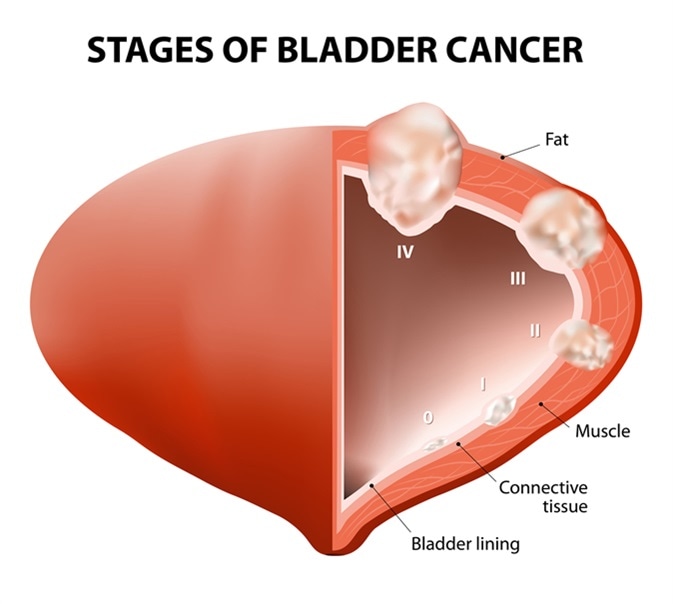The human bladder’s main function is to collect and store urine produced by the kidneys. Cancer is a disease caused by the uncontrollable division of abnormal cells within a specific part of the body. Research estimates that over 80,000 adults in the United States will be diagnosed with bladder cancer each year.
Bladder cancer is one of the most common malignancies of the urinary and genital organs. Cancer originates in the cells and is marked by out of control cell division. When abnormal cells divide uncontrollably, they form masses of tissue referred to as tumors. These tumors can grow and interfere with systems or organs within the body. The different types of cancer can be categorized depending on the type of cell they form in and the where in the body they begin to grow , such as breast or bladder cancer.

Transitional Cell Bladder Cancer
The most common type of bladder cancer is transitional cell carcinoma, otherwise called urothelial cancer. This type of cancer forms in the urothelial or transitional cells of the bladder lining. Typically, when the bladder is empty these cells group together and as the bladder fills they stretch out into one single layer. However, the cells may come into contact with toxic waste products from urine that may be carcinogenic, such as arsenic from cigarette smoke. It is this exposure to such chemicals which may be linked to the onset of the disease.
Cancers of transitional bladder cells often behave in different ways. Early stage cancers of this type do not penetrate into the deeper layers of the bladder, as opposed to invasive or last stage cancer which invades several layers of the bladder.
Early Bladder Cancer
In early bladder cancer, the cancer cells are only found in the lining of the bladder and have not grown further into the cells of the bladder walls. This type of cancer is characterized by small mushroom-shaped growths, which grow outside of the bladder’s epithelium layer and is referred to as papillary bladder cancer. Treatment options for early bladder cancer includes surgical removal of the growths. Despite the removal of the growth, in some early bladder cancers, the cancer is more likely to return. This is found to be the case in the development of carcinoma in situ (CIS) and high-grade T1 tumors.
Carcinoma in situ (CIS)
Carcinoma in situ of the bladder is more prevalent in males compared to females. Some of the risk factors include increased age, exposure to carcinogens, and genetic mutations such as p53. Lower abdominal pain, frequency and urgency of urination, and suprapubic fullness and pain, are some of the reported symptoms experienced. CIS of the bladder is flat in shape, high-grade and non-invasive.
The cancer cells look quite abnormal and grow rapidly, however, they do not grow into the bladder wall. Due to how aggressively the cells can return, individuals diagnosed with this type of bladder cancer are more likely to relapse. Furthermore, management of the cancer can be extremely complex and challenging for medical professionals due to its recurrence and progression. Some argue the difficulties surrounding diagnosing CIS of the bladder are due to the non-specific nature of symptoms.
High-Grade T1 Tumors
T1 tumors are early cancers that have grown from the bladder lining and protruded into the lamina propria, which sits underneath the lining. Like CIS, they tend to grow very quickly, and approximately 30% to 40% of T1 bladder cancers return.
Squamous Cell Bladder Cancer
A small proportion of bladder cancers are invasive squamous cell cancers (SCC). Squamous cells are flat cells that produce the skin-like tissue lining of organs, including the bladder. SCC can be further categorized into two subtypes: those caused by the bilharzia (schistosomiasis) infection or those not resulting from the infection. In the former, cases of SCC tend to occur in developing countries where it is thought to be contracted through infected worms.
Adenocarcinoma
Adenocarcinoma is an extremely rare type of bladder cancer which may arise primarily from the bladder, but also from other organs. It is thought that only 1% to 2% of all diagnosed bladder cancers are adenocarcinoma. The cancer cells typically form n the trigone and posterior walls, however, they can develop from any area within the bladder. The tumors show poor responses to chemotherapy and radiotherapy, resulting in undergoing surgical resection as the only treatment option.
There are many types of bladder cancer which largely seem to be understood in terms of their pathology. However, as the prevalence of cancer increases, research should continue to investigate its causes and symptoms allowing for early diagnosis. This may increase the survival rate in those diagnosed with the disease.
Sources
- www.cancerresearchuk.org/…/types
- www.ncin.org.uk/view?rid=2407
- https://www.ncbi.nlm.nih.gov/pmc/articles/PMC4647140/
- 10.1016/j.aju.2016.07.001
- Stein, J. P., Lieskovsky, G., Cote, R., Groshen, S., Feng, A. C., Boyd, S., … & Raghavan, D. (2001). Radical cystectomy in the treatment of invasive bladder cancer: long-term results in 1,054 patients. Journal of clinical oncology, 19(3), 666-675.
- www.macmillan.org.uk/…/types-of-bladder-cancer.html
- www.cancerresearchuk.org/…/types-of-cancer
Further Reading
- All Bladder Cancer Content
- What is Bladder Cancer?
- What Causes Bladder Cancer?
- Bladder Cancer Diagnosis
- Bladder Cancer Treatment
Last Updated: Sep 2, 2018
Source: Read Full Article






